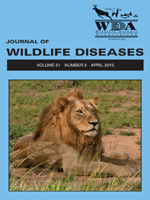Sara E. Huckabone, Frances M. D. Gulland, Suzanne M. Johnson, Kathleen M. Colegrove, Erin M. Dodd, Demosthenes Pappagianis, Robin C. Dunkin, David Casper, Erin L. Carlson, Jane E. Sykes, Weiland Meyer, Melissa A. Miller
Journal of Wildlife Diseases 51 (2), 295-308, (1 April 2015) https://doi.org/10.7589/2014-06-143
KEYWORDS: California sea lion, Coccidioides, coccidioidomycosis, Cryptococcus, Harbor Seal, sea otter, systemic mycosis, Zygomycetes
A wide range of systemic mycoses have been reported from captive and wild marine mammals from North America. Examples include regionally endemic pathogens such as Coccidioides and Blastomyces spp., and novel pathogens like Cryptococcus gattii, which appear may have been introduced to North America by humans. Stranding and necropsy data were analyzed from three marine mammal stranding and response facilities on the central California coast to assess the prevalence, host demographics, and lesion distribution of systemic mycoses affecting locally endemic marine mammals. Between 1 January 1998 and 30 June 2012, >7,000 stranded marine mammals were necropsied at the three facilities. Necropsy and histopathology records were reviewed to identify cases of locally invasive or systemic mycoses and determine the nature and distribution of fungal lesions. Forty-one animals (0.6%) exhibited cytological, culture- or histologically confirmed locally invasive or systemic mycoses: 36 had coccidioidomycosis, two had zygomycosis, two had cryptococcosis, and one was systemically infected with Scedosporium apiospermum (an Ascomycota). Infected animals included 18 California sea lions (Zalophus californianus), 20 southern sea otters (Enhydra lutris nereis), two Pacific harbor seals (Phoca vitulina richardsi), one Dall's porpoise (Phocoenoides dalli), and one northern elephant seal (Mirounga angustirostris). Coccidioidomycosis was reported from 15 sea lions, 20 sea otters, and one harbor seal, confirming that Coccidioides spp. is the most common pathogen causing systemic mycosis in marine mammals stranding along the central California coast. We also report the first confirmation of C. gattii infection in a wild marine mammal from California and the first report of coccidioidomycosis in a wild harbor seal. Awareness of these pathogenic fungi during clinical care and postmortem examination is an important part of marine mammal population health surveillance and human health protection. Temporal–spatial overlap may be observed for pathogenic mycoses infecting coastal marine mammals and adjacent human populations.

